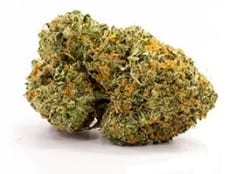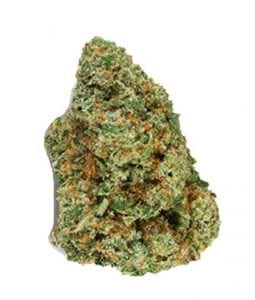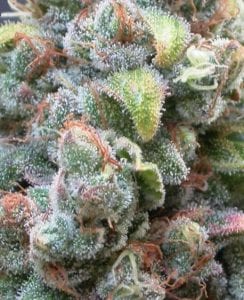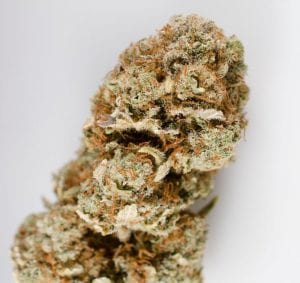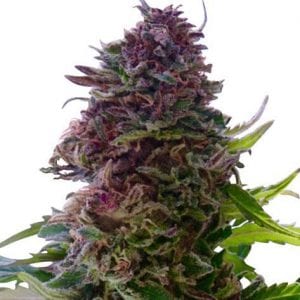Cannabis, the drug also goes by the name marijuana, has gained a curiosity in recent times for its potential value as an antiepileptic substance. Explore this post to learn how medical marijuana can decrease the adverse effects of seizures (or epilepsy). Also, have a glance at the best medical marijuana strains for seizures.
When we consider the best cannabis strains for seizures, the strain that comes to mind is the Cannatonic Cannabis Strain; visit the official website!
The two main elements of marijuana are delta-9-tetrahydrocannabinol (THC) and cannabidiol (CBD). The delta-9-tetrahydrocannabinol has had mixed results in epilepsy, wherein cannabidiol has shown more uniform antiepileptic effects. Data establishing the use of medical marijuana for this disorder are limited, as most trials were conducted before 1990. Case reports confer promising results; however, we cannot depend on the consistency of the data. Therefore, we cannot generalize it. The global legal concerns also may restrict the application of medical marijuana as an antiepileptic.
Epilepsy is repetitive and ongoing seizures caused by changes in neuronal firing in the brain. Nonepileptic seizures are not allied with neurophysiological changes. For example, 3% of the populace is predisposed to epileptic seizures. Current pharmacotherapy for epilepsy aims to reestablish neuronal capacity and decrease seizure recurrence. Prospective, randomized experiments conclude that individuals experiencing a first, unwarranted seizure have a 40% to half possibility of seizure repeat at two years.
The risk of repeat, which diminishes with time, is highest quickly following the first seizure, with 80% to 90% of patients experiencing repetitive seizures within the first two years. Despite available treatments, about 30% of patients stay resistant to therapy, resulting in poorly controlled and recurring seizures. This review discusses the ebb and flows of research on the method of reasoning for and limitations to the use of marijuana to treat seizure disorders.
Historical Usage of Medical Marijuana
Contents
The earliest archived use of cannabis occurred in around 2,700 BC in China. It was useful for various clinical ailments, including gout, intestinal sickness, constipation, menstrual disorders, and absentmindedness. Western medication used medical marijuana as a common analgesic in the nineteenth century. Cannabis strains were accessible in US pharmacies as an OTC product until the Marihuana Tax Act of 1937 restricted its accessibility.
Consequently, the Controlled Substances Act grant in 1970 proffered medical marijuana into a Schedule-I class, making its usage illegal. Since 1970, there has been a rising interest in applying marijuana for its possible antiepileptic qualities.
Medical Marijuana Strains and Pharmaceutical Science
Cannabis Sativa and Cannabis Indica are two varieties of plants. Both of these varieties have a long history of effectiveness as antiepileptics. Moreover, Sativa strains produce more psychotropic and stimulating effects, and Indica strains produce more sedative effects. Compounds held in the medical marijuana strains are known as cannabinoids. Cannabis comprises two main components: the psychoactive delta-9-tetrahydrocannabinol (THC) and the nonpsychoactive cannabidiol (CBD).
The type-1 receptors do the job here to make the connection between cannabis and seizures. The presence of cannabinoid type-1 receptors in the hippocampus and amygdala makes cannabis an attractive agent for epilepsy, the two connected with deficient seizures. The THC segment of cannabis is a fractional agonist at these receptors.9 Conversely, CBD interacts with other nonendocannabinoid signaling systems, reducing THC’s psychotropic activity while increasing tolerance. Recent tests of CBD have revealed more compatible anticonvulsant characteristics, and this cannabinoid has gained curiosity as a possible agent for epilepsy. In addition, there are numerous potential administration routes for synthetic CBD. The first non–delta-9-THC phytocannabinoid was assessed for its anticonvulsant effects in clinical trials.
The most widely recognized delivery course is by inward breath, either recreationally or therapeutic. Because of CBD’s highly lipophilic nature and its high volume of distribution, the lungs are a practical course of prescription delivery, with quick distribution into the brain, adipose tissue, and organs. Cannabinoids are widely utilized by the liver, mainly by CYP3A2, CYP3A4, CYP2C8, CYP2C9, and CYP2C19. Owing to the first-pass metabolism through the liver, CBD is approximately 6% bioavailable, hence rendering oral, oral-mucosal, and sublingual delivery methods less acceptable.
The transdermal passage of administration has also been there; however, this course might be economically impractical since one-of-a-kind delivery systems are expected to forestall excessive aggregation of CBD in the skin.
Side Effects of Treating Seizures and Epilepsy with Marijuana
Clinical trials examining the adequacy of marijuana for treating epilepsy are limited. Probably the earliest was a small randomized, controlled study directed by Mechoulam in 1970. In this case, nine subjects with treatment-resistant temporal lobe epilepsy took either CBD or placebo for five weeks, along with antiepileptic therapy. Two out of four CBD patients were seizure-free at a 3-month development, whereas none of the five placebo patients showed improvement. However, this preliminary was limited by its small sample size and absence of statistical analysis or power count.
Cunha and colleagues directed a small randomized, controlled preliminary involving 15 patients with generalized epilepsy. Seven patients got CBD, and eight got a matching placebo for 3 to 18 weeks. There were no recorded toxicities, and four CBD patients matched with just one placebo were seizure-free. This research was limited because it did not perform power figuring or analytical interpretation and used a small sample.
Although several controlled studies demonstrated some viability of CBD for epilepsy, more ongoing studies indicate that CBD has narrowed or no effect on epilepsy. In one preliminary, Trembly and Sherman inspected the effect of marijuana on uncontrolled epilepsy. However, the research found no overall discernible effect and no statistical analysis of preliminary outcomes or principle effects. However, a study led by Ames and Cridland showed no difference between CBD and placebo. However, as was the case in earlier tests, the study populace was small, and there were no power calculations.
Various case reports have identified grown-up patients favoring marijuana as antiepileptic treatment and parents who have tried marijuana with CBD content to manage resistant epilepsy in their children. Some of these records produce promising data. However, there is no representation of dosage, description, course of conduct, or span of medical marijuana therapy.
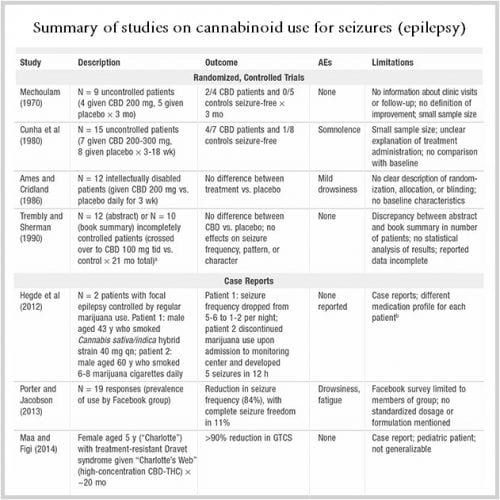
The placebo effect and recall bias might be confounding variables. These limited case reports highlight an absence of safety and adequacy information from randomized, controlled trials to confirm the use of cannabis for the treatment of epilepsy. Check image-1 for a summary of studies on cannabinoid application as an antiepileptic agent.
Adverse Effects of Cannabis Usage
Adverse effects of constant marijuana use incorporate habit risk, negative effects on brain advancement, increased risk of certain psychological sicknesses, engine vehicle accidents, and various health effects. Diagnostic and Statistical Manual of Mental Disorders (DSMMD) unveils that 9% of people who utilize medical marijuana may get addicted. Besides, discontinuing regular cannabis use may cause withdrawal symptoms such as cravings, irritability, insomnia, and nervousness.
Cannabis admission at a young age may affect brain improvement, as it can debilitate neural connectivity in particular brain areas, resulting in remodeled learning, memory, and capacity. Marijuana use in adolescence could prompt a heightened response to other drugs, paving the route for addictions to other drugs in adulthood. Consistent marijuana use relates to tension and depression; however, a causal relationship is not accessible. There may also be a definite relationship between marijuana smoking and an increased frequency of lung cancer and other pneumonic illnesses through lung aviation route aggravation, aviation route resistance, and hyperinflation.
Heavy and constant marijuana use may incite the most adverse effects, mostly attributable to THC. However, there may also be puzzling variables; hence, the causality report is not accessible. Prospective studies of CBD may emerge in a different side-effect outline. For example, differences in CBD safety in humans have shown satisfactory resistance with no notable side effects at a dosage up to 1,500 mg daily by mouth or 30 mg IV when used intensely and chronically.
Legalized Medical Usage of Cannabis
While 33 US states have approved medical marijuana, the other 17 states have all passed bills supporting CBD (cannabidiol) extract, commonly in oil form, with minimum THC (tetrahydrocannabinol), and often for the remedy of seizures and epilepsy in severely sick children. Besides, Massachusetts allows marijuana for conditions as decided in writing by a qualifying patient’s physician. Canada, along with the Netherlands and Israel, allows the use of medical marijuana.
Future research involving drug products of cannabis or synthetic substances that act like cannabis must precisely utilize an Investigational New Drug Application before human trials. Besides, the DEA (Drug Enforcement Administration) examines the researcher’s application. Also, the National Institute of Drug Abuse is prone to deliver research on medical marijuana for experiments. Eventually, for a drug product to get legal in the US, the FDA must ensure that it meets the necessary quality standards and is safe and productive.
Best Cannabis Strains for Seizures and Epilepsy
1 – Cannatonic from ILGM
Cannatonic created a generally light and smooth high that doesn’t last as long as other strains, but it is also enjoyable for that reason. This strain doesn’t make you feel lazy but instead allows you to feel like you are lighter after dumping all of the burdens on your shoulders. This hybrid makes you feel relaxed and confident, floating on a dreamy haze of happy feelings. Cannatonic allows you to feel motivated without the increase of energy; it is a lot quiet, more soothing sort of high that will make you smile wildly in a constant state of feeling thrilled.
Cannatonic induces a composed high that can increase your focus and push you to sort your thoughts, slowly making a judgment of any ideas you may have. This bud will make you need to be more productive with your day and encourage you to stay in a constant state of pleasure while being productive.
2 – ACDC from Crop King Seeds
One strain that can efficiently alleviate discomfort in ACDC. It is a famous strain with high CBD material; that’s the favorite of patients suffering from IBS’s chronic pain and also discomfort. It is a Sativa-dominant strain and a phenotype of Cannatonic. It implies that it is medical marijuana with extremely little to absent psychedelic results. ACDC has a THC: CBD balance of 1:20 with THC at approximately 19%. You can practice ACDC to overcome conditions like tension and depression with its all-natural mood-enhancing impacts. It’s a good anti-seizure strain that may help to manage headaches, chronic pain, back pain, and much more.
Treating epilepsy, seizure disorders, Dravet syndrome, IBS, or other inflammatory conditions with ACDC can be proven revolutionary. You can additionally depend on ACDC for the alleviation of physical and also psychological tiredness. Like other medical strains, ACDC may cause red eyes, small paranoia, and cottonmouth. These adverse effects could be kept minimum by consuming this weed in a modest dose.
3 – Charlotte’s Web from Sensible Seeds
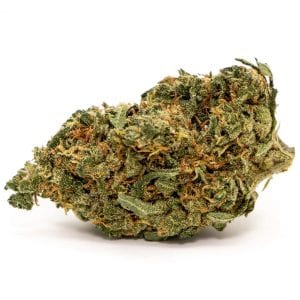
Charlotte’s Web is one of the best medical marijuana strains that may treat Dravet syndrome without side effects. Charlotte’s Web is a Sativa-dominant cannabis strain with higher CBD levels. What makes this strain novel is that it got its name after Charlotte Fiji, a young girl suffering from Dravet Syndrome, which causes her to have several seizures every day.
Charlotte’s Web became the focus of an across-the-country exertion to make clinical marijuana legally accessible for epileptic patients like Charlotte. Charlotte’s Web is mostly Sativa. However, due to the absence of THC focus in the strain, possible psychedelic effects are negligible. For example, strains with a high CBD to THC ratio, Cannabidiol CBD, or CBD oil may help as an anti-seizure element.
Some users would describe its effects as focusing mostly on the physical. Thus, users generally feel more relaxed after intake. However, the Sativa effects of Charlotte’s Web improve a user’s disposition and provides happy feelings, focus, and oozing energy. With an astounding CBD fixation reaching as high as 17%, Charlotte’s Web is an ideal substitute for those suffering from specific health conditions.
4 – Ringo’s Gift from Canadian Hemp Co
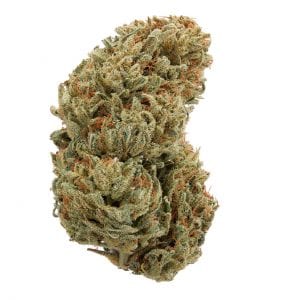
Ringo’s Gift is an additional therapeutic strain named after Lawrence Ringo, a cannabis activist and a CBD advocate. The strain is a CBD-dominant weed made by incorporating a Harle-Tsu and ACDC. Ringo’s Gift offers analytical stimulation and also relaxation. You will undoubtedly love its beautiful, earthy, and flowery tastes, making you return for more. Ringo’s Gift features a CBD of 15.8% and 0.6% THC. This high CBD is among the reasons it is a part of the food selection of popular coffee bars in the Netherlands. With Ringo’s Gift, you’ll get a mix of cerebral activity and healthy relaxation without side effects. Ringo’s Gift is a good anti-seizure strain that may help to manage headaches, chronic pain, back pain, and much more.
This crossbreed is known to treat swelling, consisting of IBS signs and symptoms. You can finish pain like belly pains, frustrations, migraine headaches, arthritis, chronic discomfort, muscular tissue pains, and strains. You can use Ringo’s Gift to quit anxiety and clinical depression because it uplifts and loosens. If you have had trouble sleeping, this strain can additionally aid you out. It can stop sleeping disorders and insomnia and get that good night’s sleep with Ringo’s Gift. Ringo’s Gift is one of the best medical marijuana for seizure disorders.
5 – White Widow from ILGM
The White Widow medical marijuana is reasonably the most famous and notable strain. White Widow is usually the first marijuana strain that most individuals attempt. Hence, it makes sense that such a significant number of individuals go to it to help them with neuropathy. The thing that makes this strain so great is its monstrously high THC levels. THC at 25%, this strain is easily one of the strongest on the planet.
The ‘high’ of White Widow leaves you revitalized, yet somehow still super relaxed and relaxed. This strange blend of sensations makes it ideal for getting you through awkward pains. It makes you painless, but you will also feel comfortable, quiet, and excited about your surroundings. Stunningly better, it doesn’t cause any tiredness, as such a significant number of other potent Indica strains, so it’s ideal for daytime use. It is an incredibly even strain that makes those suffering from neuropathy feel like their concern is a thing of the past.
The main potential issue is that it is easy to accidentally smoke an excessive amount of White Widow without a moment’s delay, potentially bringing on some powerful feelings of tension or suspicion. The most reliable way to avoid this strain is to go slow with a moderate dosage.
6 – Green Crack from ILGM
Green Crack produces a powerful head-high, earning itself the much-deserved title of one of the most mainstream Sativa around. It is euphoric, and the ‘high’ mixed in with a sense of being relaxed is among its most excellent traits. Green Crack can give that without the feeling of a substantial body if you are seeking a lift of energy rapidly in the day. For anybody looking to inspire and boost creativity, Green Crack is a perfect marijuana strain.
It enables the user to stay concentrated while having a general vibe and good state of mind with a boost of energy. Numerous individuals pick Green Crack as a day-starter – regardless, replacing their sturdy mug of coffee with it. The energetic, cerebral effect Green Crack provides is for enhancing focus. It has been famous for quite a long time when you need a little boost to finish your tasks, such as running errands, building, or cleaning. Another effect is that Green Crack causes a feeling of hunger strike, an attractive trait that adds to its popularity.
7 – CBD Chronic from Dinafem Seeds

CBD Chronic is a cross strain between CBD Crew and Serious Seeds. It arises from the well-known Chronic strain, a therapeutic strain with high CBD content. The overall ratio of THC-CBD provided by this plant is 1:1. The sample with the most potent overall amounts claimed 7.88% THC and 6.93% CBD. Like the original Chronic strain, CBD Chronic is very easy to grow. Besides, it’s one of the strains that beginners can try without side effects.
It is a weed strain that first gets trials in therapeutic research. The high-CBD strain is useful for extracts such as ointments, cremes, lotions, and CBD oil. CBD Chronic is a good anti-seizure strain that can also be used to manage headaches, chronic pain, back pain, and much more.
8 – Harlequin from ILGM
This dominant hybrid is a great smoke when looking for psychological release without feeling exhausted. Harlequin has received all its positive results from its origin. This strain is a remarkable relaxant, able to quiet the mind and stay focused.
Harlequin is uplifting and a happiness-inducing weed. This Sativa-dominant cannabis will let you keep your productivity at 100 percent without side effects. It means that it’s the ideal smoke to start a day with because instead of slowing you down, this strain may assist you with getting stuff done and getting it done while feeling inspired and creative. Harlequin is excellent at keeping you focused and will let make them complete your usual tasks with more exactness and vigor.
9 – Granddaddy Purple from ILGM
Because GDP is a classic Indica, it can make an intense head high, leaving you to quiet down and generate a fresh brain buzz. Grand Daddy Purple offers just that without side effects for those seeking a profound and relaxing recreational high. It is a powerful sleep help, which makes it the ideal nighttime puff.
Not only does it assist you with unwinding and letting go of all your stresses, but it also leaves you feeling happy and content. It is what makes it an excellent ally for a warm air pocket shower toward the day’s end. A sense of rapture is one of the effects of Grand Daddy Purple. And it renders a sense of happiness and a strong desire to laugh. Sometimes, GDP can encourage a voracious appetite but isn’t present in each user.
10 – Romulan from Seed Supreme
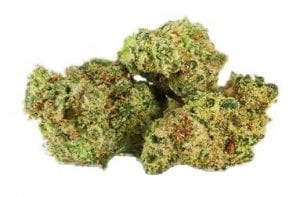
You should go for it if you want to be fruitful on this strain. This potent Indica will make you succumb to gravity without even an opportunity to fight it. Its ‘high’ can deliver a substantial body with a guaranteed lounge chair lock – so it is fully appreciated when you can hit back and relax.
This strain will make you sense that you are in a full body massage, just as you’re lying down. Romulan is an ideal relaxant, really undoing the knots in your back and making you have an inclination that you are floating on a cloud in a dense brain haze. If you continue smoking, you may get sleepy, which is the ideal nighttime smoke altogether.
It will mitigate your negative thoughts and make you feel floaty. You will feel relaxed and hungry, making you comfortable without side effects.
Final Verdict
Firstly, there is inadequate data to form a reliable conclusion about the effectiveness of marijuana as an antiepileptic agent. Notwithstanding case reports showing effectiveness in decreasing seizure recurrence and severity, there are insufficient clinical studies on its suitability for this implication. Secondly, the studies were insufficient, lacked comprehensive information, and used small sample sizes. Finally, there is research on the long-term treatment of cannabis and its safety outline.
Recently, legal limitations on cannabis made it complicated to carry out large-scale clinical experiments. For example, the FDA has listed marijuana as a Schedule-I controlled substance. Therefore, we cannot ascertain the efficacy of cannabis for the therapy of epilepsy presently. Instead, more large-scale study results should be available that evaluate the potency and safety of cannabis administration with either high CBD-THC ratio cannabis or separate CBD composites.
Frequently Asked Question
What is a decent cannabis strain for seizures?
Charlotte’s Web and Cannatonic are the best strains that proved effective in treating seizures in individuals with various illnesses and syndromes.
What terpene is beneficial to seizures?
Linalool may be found in lavender, mint, cinnamon, and coriander, among other things. Surprisingly, like aromatic plants, it has strong sedative and calming qualities. This one-of-a-kind terpene has helped patients with arthritis, depression, seizures, sleeplessness, and cancer.
Is it preferable to use Indica or Sativa for epilepsy?
Both indica and Sativa are helpful in epilepsy but choose the one with high CBD. However, hybrid strains can give you the best solutions.
Can CBD assist with epilepsy?
Although further study is needed, some people have reported beneficial outcomes when taking CBD to treat epilepsy. For example, strains with high CBD help treat epilepsy and seizures.
Is CBD effective in treating seizures?
CBD has been shown to help prevent some types of seizures in humans and animals. Clinical trials, for example, have shown a substantial reduction in seizures in persons using CBD to treat Lennox-Gastaut syndrome, Dravet syndrome, or tuberous sclerosis complex.
Does marijuana assist with neuropathy?
Cannabis has been shown in small clinical studies to treat peripheral neuropathy, including pain relief, better sleep, and increased function, even in people with symptoms that are resistant to traditional medications.
What are the best strains for seizures?
Seizures benefit from Cannatonic, ACDC, Charlotte’s, Ringo’s, and White Widow.
What foods can help with seizures?
A low glycemic index diet emphasizes foods having a low glycemic index, which means they have a slow if any, effect on blood glucose levels. However, it is unknown why low blood glucose levels control some people’s seizures. Meat, cheese, and most high-fiber vegetables are included in this diet.
What is the purpose of Grand Daddy Purple?
Granddaddy Purple is well recognized for its soothing euphoric effects that ease tension and help you sleep comfortably. This mellow, calming strain provides blissful relaxation and contentment, akin to Kaya Romulan and Blueberry OG.
Is indica sedative or stimulating?
Indica strains are both soothing and stimulating. Many individuals find that indica strains make them tired, which may benefit those with insomnia. Pain-relieving. Indica can put you on relaxation.

